- Dodder: A Unique Parasitic Plant
- Characteristics
- Life Cycle
- Impact on Ecosystem
- Prevention and Control
- Conclusion
- Characteristics and Identification of Dodder
- 1. Lack of Chlorophyll
- 2. Thin, Twining Stems
- 3. Leafless
- 4. Absence of Roots
- 5. Flowering and Seed Production
- 6. Host Preference
- 7. Recognizing Dodder Infestation
- 8. Prevention and Control
- How Dodder Infects and Weakens Host Plants
- Dodder’s Infecting Process
- Weakening of Host Plants
- The Impact of Dodder on Agriculture and Ecosystems
- 1. Crop Yield Reduction
- 2. Disease Transmission
- 3. Ecological Disruption
- 4. Economic Costs
- 5. Spread and Infestation
- Recognizing Dodder Infestations – Signs and Symptoms
- 1. Yellowing and wilting of host plants
- 2. Thin, thread-like stems
- 3. Lack of leaves
- 4. Dense clusters of small, white or pink flowers
- 5. Twisted and tangled appearance
- 6. Spread through neighboring plants
- Combating Dodder Infestations: Prevention and Control
- Preventing Dodder Infestations
- Controlling Dodder Infestations
- Chemical and Biological Methods to Eliminate Dodder
- Chemical Methods
- Biological Methods
- Questions and Answers:
- What is dodder?
- How does dodder spread?
- What are the signs of a dodder infestation?
- Is dodder harmful to plants?
- Can dodder be controlled or eradicated?
- How can dodder be prevented from spreading?
- Are there any natural predators or parasites of dodder?
- Videos: Dodder’s Secret Life: A Plant That Doesn’t Need Sunlight?
Dodder, scientifically known as Cuscuta, is a unique and fascinating plant that has a parasitic lifestyle. Unlike most plants that photosynthesize and obtain nutrients from the soil, dodder lacks chlorophyll and relies entirely on other plants for survival. This makes it an important plant to recognize and combat, as it can cause significant damage to crops and native vegetation.
Recognizing dodder can be challenging, as it has a unique appearance and behavior. It is a thin, thread-like vine that wraps itself around the host plant, forming a dense and tangled mass. Dodder produces small, white or pink flowers that are clustered together, giving it a distinct and eye-catching appearance. These flowers eventually develop into small, round seed pods.
One of the most alarming aspects of dodder is its ability to spread rapidly and infest large areas. The seeds of dodder are tiny and can be easily dispersed by wind, water, animals, and human activity. Once the seeds germinate, dodder quickly establishes itself on a host plant and begins to extract nutrients. If left unchecked, dodder can weaken and eventually kill its host plant.
To combat dodder infestations, it is important to take preventative measures and early detection. Regularly inspecting crops and garden plants for signs of dodder is crucial. If dodder is detected, it is essential to remove it as soon as possible. This can be done by carefully unwrapping the dodder vines from the host plant, being careful not to damage the host plant in the process.
In conclusion, dodder is a parasitic plant that poses a significant threat to crops and native vegetation. Recognizing dodder’s unique appearance and behavior is essential for early detection and control. By taking preventative measures and promptly removing dodder infestations, we can protect our plants and mitigate the damage caused by this fascinating yet destructive plant.
Dodder: A Unique Parasitic Plant
Dodder, also known as Cuscuta, is a remarkable parasitic plant that belongs to the Convolvulaceae family. It is a highly adaptive and destructive plant that relies on other plants for survival.
Characteristics
The dodder plant has thin, thread-like stems that are yellow, orange, or red in color. These stems lack chlorophyll, making it unable to produce its own food through photosynthesis. Instead, it depends on its host plant for nutrients and water.
Unlike other plants, dodder seeds don’t have any stored food reserves. Once the seed germinates, it needs to find a suitable host plant within a few days to survive. The dodder seedlings are highly sensitive to chemicals released by potential host plants and are attracted towards them.
Life Cycle
Once the dodder seedling reaches a host plant, it produces small, root-like structures called haustoria, which invade the host plant’s tissues. These haustoria penetrate the host’s vascular system, allowing the dodder to extract nutrients and water directly from the host.
As the dodder grows, it forms dense clusters of tangled stems around the host plant, depriving it of essential resources and eventually leading to its decline or death.
Impact on Ecosystem
Dodder is considered a detrimental plant for agricultural crops as it can significantly reduce crop yield. It has a wide range of host plants, including vegetables, fruits, and ornamental plants. Once established, it is challenging to eradicate. It can also spread easily through its numerous tiny seeds, wind, water, and even contaminated equipment.
Prevention and Control
Preventing the spread of dodder is essential to protect crops and maintain plant health. Some measures that can be taken to combat dodder infestations include:
- Using certified, clean seeds and transplants to reduce the chances of introducing dodder into the field.
- Removing dodder-infested plants from the field and burning or disposing of them properly.
- Avoiding the use of dodder-infested water for irrigation.
- Maintaining proper field hygiene by removing weed hosts that can serve as potential sources of dodder infestation.
- Using pre-emergent herbicides to prevent dodder seed germination.
- Applying post-emergent herbicides selectively on dodder-infested plants.
Conclusion
Dodder is a unique parasitic plant that poses a significant threat to agricultural crops and natural ecosystems. Understanding its characteristics, life cycle, and control methods can help in recognizing and effectively combating dodder infestations. Implementing preventive measures and early detection are key to minimizing the damage caused by this destructive plant.
Characteristics and Identification of Dodder
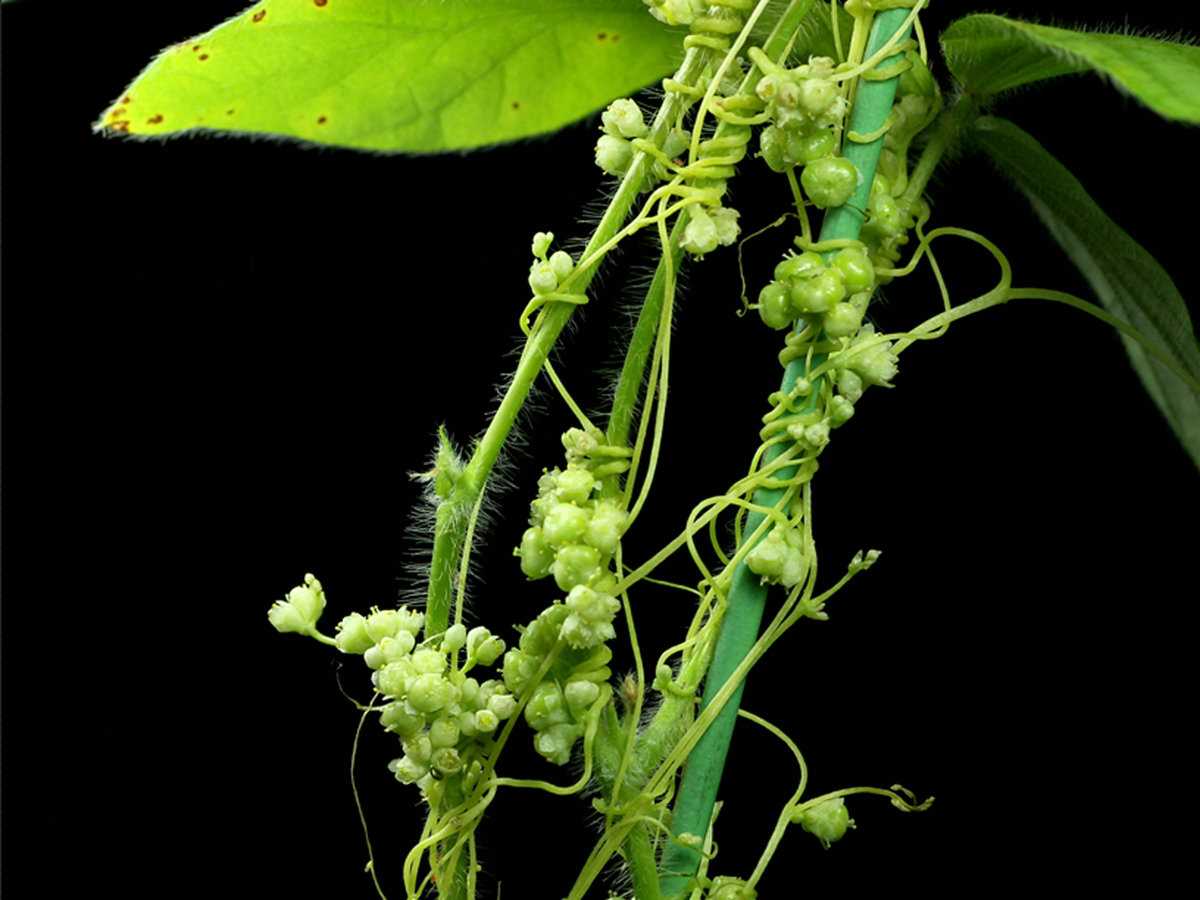
Dodder is a unique and fascinating parasitic plant that can be found in various parts of the world. It belongs to the family Cuscuta and is known for its ability to attach itself to and feed off of other plants. Here are some key characteristics and identification features of dodder:
1. Lack of Chlorophyll
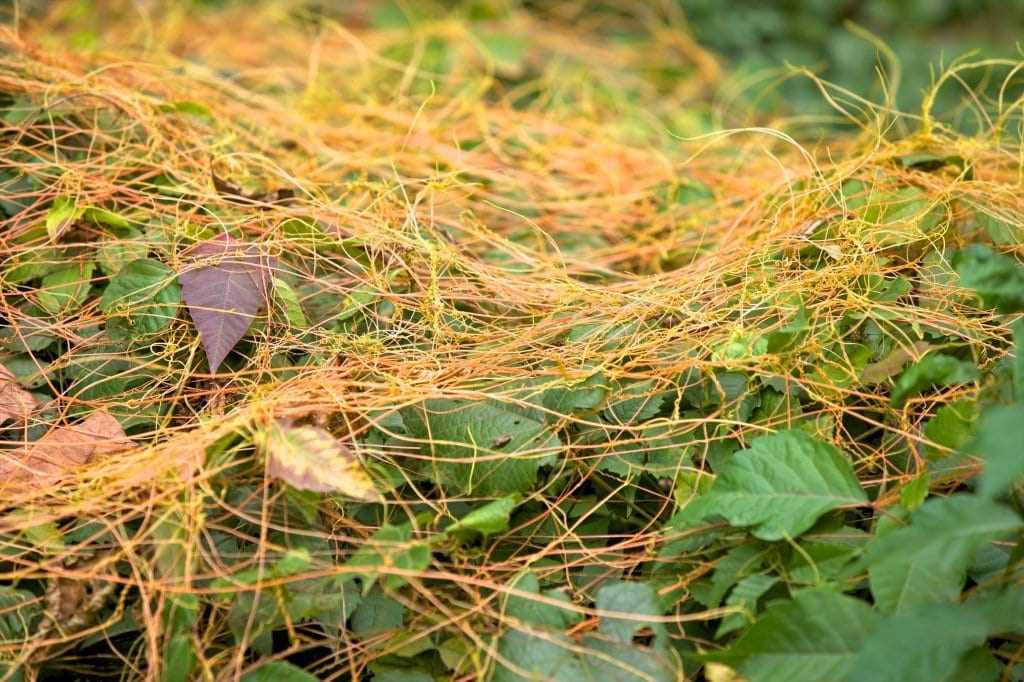
Dodder plants lack chlorophyll, which is the pigment responsible for photosynthesis in most plants. This means that dodder cannot produce its own food and relies entirely on its host plant for nutrition.
2. Thin, Twining Stems
Dodder has thin, thread-like stems that wrap around the stems and branches of its host plant. These stems are pale yellow or orange, giving dodder a unique and striking appearance.
3. Leafless
Unlike most plants, dodder does not have leaves. Instead, it has small scale-like structures called scale leaves that serve mainly as protection for the plant.
4. Absence of Roots
Another distinguishing characteristic of dodder is the absence of true roots. Instead, it has small structures called haustoria that penetrate the host plant’s tissue to extract nutrients.
5. Flowering and Seed Production
Dodder produces small, white or pink flowers that are arranged in clusters. These flowers eventually turn into small capsules containing numerous seeds. The seeds are tiny, light-colored, and have a rough surface.
6. Host Preference
Dodder is not selective when it comes to choosing its host plant. It can parasitize a wide range of plant species, including trees, shrubs, and herbaceous plants.
7. Recognizing Dodder Infestation
Identifying dodder infestation can be challenging, especially in its early stages. However, some signs that indicate the presence of dodder include the presence of intertwined stems, the absence of leaves on certain parts of the host plant, and stunted or yellowing growth of the host plant.
8. Prevention and Control
Preventing and controlling dodder can be difficult once an infestation occurs. However, some measures that can be taken include early detection and removal of infected plants, maintaining a healthy and vigorous plant population to reduce susceptibility to dodder, and practicing proper sanitation and hygiene in agricultural practices.
In conclusion, dodder is an interesting and complex parasitic plant that can cause harm to various plant species. Understanding its characteristics and identification features is crucial for recognizing and combatting dodder infestation.
How Dodder Infects and Weakens Host Plants
Dodder is a parasitic plant that infects and weakens its host plants in a unique and destructive way. It is important to understand how Dodder infects and weakens host plants in order to effectively combat its spread and minimize damage to crops and gardens.
Dodder’s Infecting Process
- Dodder starts its infecting process by germinating from seeds in the soil.
- Once germinated, Dodder produces a small thread-like structure called a haustorium.
- The haustorium seeks out nearby host plants by detecting chemical signals released by the host.
- Once a host plant is found, the haustorium attaches itself to the host’s stem.
- Dodder pierces the host plant’s stem with specialized structures called haustoria.
- These haustoria invade the host’s vascular system, allowing Dodder to extract water and nutrients directly from the host.
- As Dodder grows, it twines around the host plant, forming a dense mass that can completely cover the host.
Weakening of Host Plants
As Dodder drains water and nutrients from host plants, it weakens them and negatively affects their growth and development. Some ways in which Dodder weakens host plants include:
- Nutrient depletion: Dodder absorbs essential nutrients from the host, causing nutrient depletion in the host plant. This can lead to stunted growth and reduced productivity.
- Water competition: Dodder competes with the host plant for water, which can result in water stress for the host. This can cause wilting, leaf discoloration, and reduced photosynthesis.
- Reduced photosynthesis: Dodder can cover the leaves of the host plant, reducing their exposure to sunlight. This inhibits photosynthesis, leading to decreased energy production and weakened plant growth.
- Inhibition of hormone signals: Dodder releases chemical signals that interfere with the hormonal communication between plant cells. This disruption can lead to abnormal growth patterns and physiological disorders in the host plant.
- Increased vulnerability to other pests and diseases: Weakened host plants are more susceptible to other pests and diseases, further exacerbating the damage caused by Dodder.
Recognizing the signs of Dodder infection and understanding how it weakens host plants is crucial for early detection and effective management. By implementing appropriate control measures, such as removing infected plants and applying herbicides, the spread and damage caused by Dodder can be minimized.
The Impact of Dodder on Agriculture and Ecosystems
Dodder, a parasitic plant, has significant impacts on agriculture and ecosystems. As a parasitic plant, dodder obtains its nutrients by invading the vascular tissues of host plants. This invasive behavior can lead to a range of negative effects.
1. Crop Yield Reduction
Dodder is known to attack a wide range of crops, including vegetables, fruits, and grains. Its invasive nature allows it to divert resources from the host plant, leading to reduced crop yield. In severe cases, dodder infestations can cause significant losses for farmers and impact food production.
2. Disease Transmission
Dodder can act as a vector for various plant diseases. When it invades a healthy host plant, it can transmit pathogens and diseases to the host, leading to widespread infection. This can result in the destruction of entire crops and further contribute to reduced agricultural productivity.
3. Ecological Disruption
Dodder’s aggressive growth can disrupt natural ecosystems. It can overtake and outcompete native plant species, leading to a loss of biodiversity. Additionally, dodder’s ability to parasitize a wide range of plant hosts allows it to spread quickly and colonize new areas, negatively impacting native plant populations.
4. Economic Costs
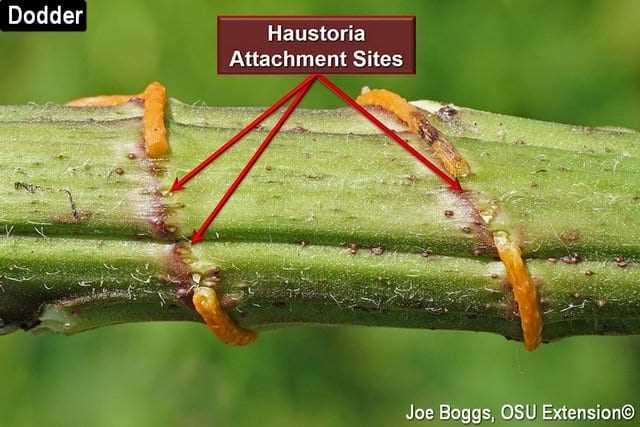
The presence of dodder in agricultural fields requires additional time and resources for control and management. Farmers often need to implement various methods, such as manual removal or herbicide application, to combat dodder infestations. These control measures can result in increased production costs and decreased profitability for farmers.
5. Spread and Infestation
Dodder is notorious for its ability to spread rapidly. Its seeds, which are small and easily dispersed by wind or water, can quickly establish new infestations over large areas. This makes dodder difficult to control and eradicate once it has become established in an ecosystem.
In conclusion, the impact of dodder on agriculture and ecosystems is significant. It can reduce crop yields, transmit diseases, disrupt ecosystems, impose economic costs, and spread rapidly. Effective management strategies and awareness are essential to minimize the negative effects of dodder on agricultural productivity and native plant populations.
Recognizing Dodder Infestations – Signs and Symptoms
Dodder is a parasitic plant that can wreak havoc on a variety of crops and ornamental plants. Being able to recognize the signs and symptoms of a dodder infestation is crucial in order to take appropriate action and prevent further damage.
1. Yellowing and wilting of host plants
One of the first signs of a dodder infestation is the yellowing and wilting of host plants. Dodder extracts nutrients from its host, weakening it and causing the plant to exhibit signs of stress.
2. Thin, thread-like stems
Dodder has thin, thread-like stems that wrap around the host plant and other nearby objects for support. These stems lack chlorophyll, giving them a pale yellow or orange color.
3. Lack of leaves
Unlike most plants, dodder lacks leaves and relies solely on its host plant for nutrition. This absence of leaves can be a notable characteristic when trying to identify a dodder infestation.
4. Dense clusters of small, white or pink flowers
As dodder matures, it produces dense clusters of small, white or pink flowers. These flowers are usually seen in late summer or early fall and can help in distinguishing dodder from other plants.
5. Twisted and tangled appearance
Dodder has a distinct twisted and tangled appearance due to its habit of intertwining with nearby plants and objects. This makes it easier to spot and differentiate from non-parasitic plants.
6. Spread through neighboring plants
Dodder spreads by wrapping its stems around neighboring plants and using them as hosts. Look for dodder stems attached to multiple plants in close proximity as a sign of a potential infestation.
By recognizing these signs and symptoms, you can take prompt action to control or eradicate dodder infestations, protecting your plants from further damage.
Combating Dodder Infestations: Prevention and Control
Dodder infestations can be highly damaging to crop plants and other vegetation. However, there are several strategies that can be employed to prevent and control dodder infestations.
Preventing Dodder Infestations
- Ensuring Clean Seeds: Before planting, make sure to use certified, dodder-free seeds to minimize the risk of infestation.
- Proper Field Sanitation: Maintain clean fields by removing any dodder-infested plants and plant debris.
- Implementing Crop Rotation: Frequently rotate crops to disrupt the life cycle of dodder and reduce the chances of infestation.
- Controlling Weeds: Regularly remove weeds from fields and surrounding areas, as they can serve as alternate hosts and sources of dodder infestation.
Controlling Dodder Infestations
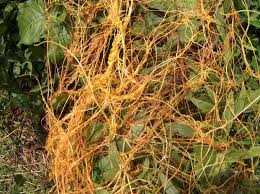
If dodder infestation occurs, it is important to take immediate action to prevent further spread. Here are some recommended control measures:
- Manual Removal: Handpick and remove dodder plants from infested areas. Be careful to remove the entire plant, including the root-like structures known as haustoria.
- Mulching: Apply a thick layer of organic mulch to smother the dodder and prevent it from accessing sunlight.
- Chemical Control: Use selective herbicides that specifically target dodder while minimizing damage to desirable plants. It is essential to carefully read and follow the instructions provided by the manufacturer.
- Biological Control: Introduce natural enemies of dodder, such as parasitic wasps and predatory mites, to reduce infestations. However, caution should be exercised when using biological control methods to avoid unintentional harm to beneficial plants and insects.
- Preventive Planting: Some plant species, such as marigold, can act as “trap crops,” attracting dodder and preventing its spread to valuable crops.
| Prevention | Control |
| Use clean seeds | Manual removal |
| Maintain field sanitation | Mulching |
| Implement crop rotation | Chemical control |
| Control weeds | Biological control |
| Preventive planting |
Chemical and Biological Methods to Eliminate Dodder
Dodder is a highly resilient and parasitic plant that can quickly spread and infest a wide range of crops and plants. Eradicating dodder from an affected area can be challenging, but there are several chemical and biological methods that can help combat this invasive weed.
Chemical Methods
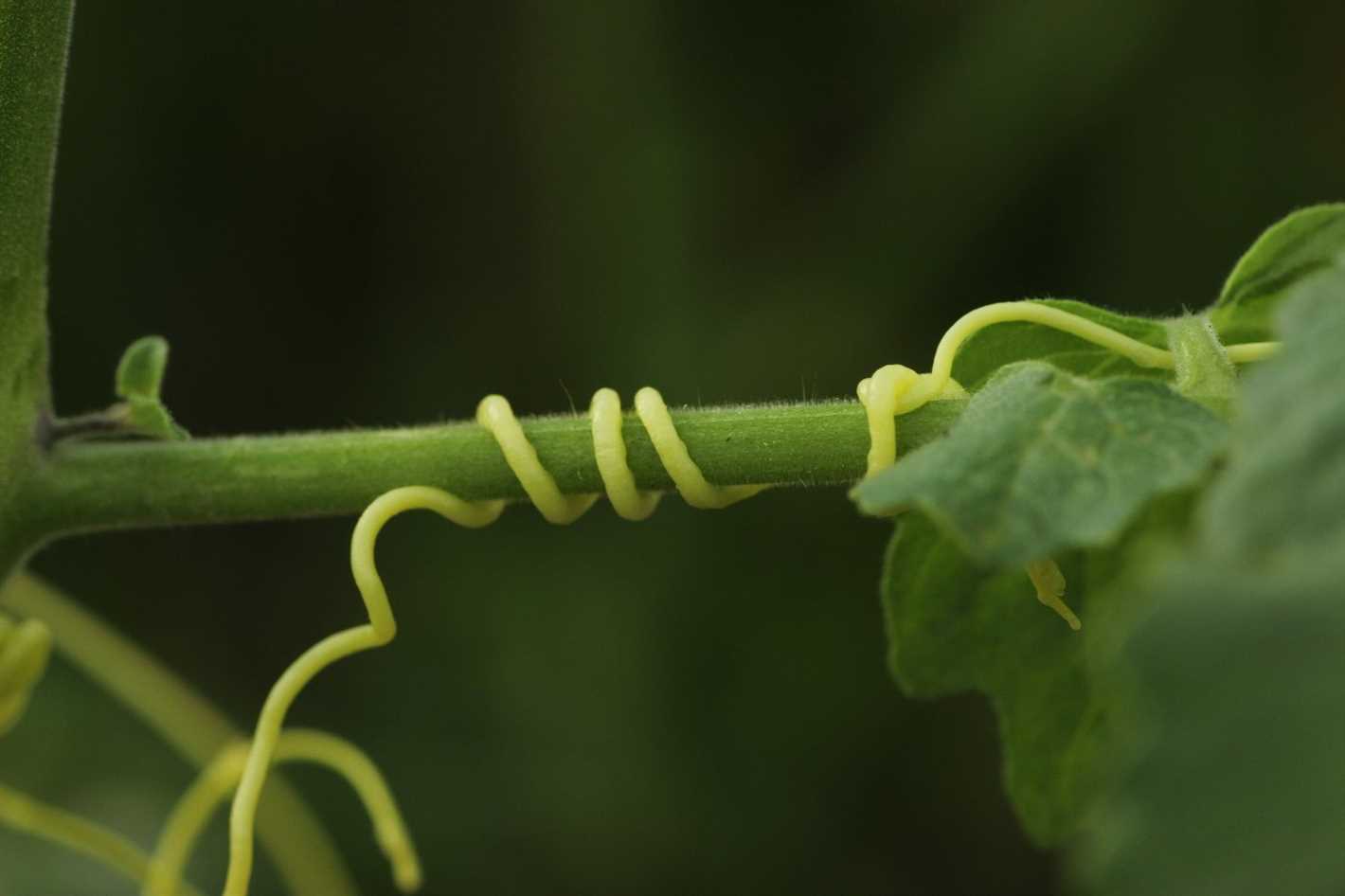
1. Herbicides: There are selective herbicides available that can effectively control dodder without harming the host plant. These herbicides should be applied following the manufacturer’s instructions and during the appropriate growth stage of the dodder.
2. Post-emergent herbicides: Post-emergent herbicides are applied after the dodder has emerged from the ground. These herbicides can be effective in controlling the above-ground growth of the dodder and preventing its spread.
3. Pre-emergent herbicides: Pre-emergent herbicides are applied before the dodder germinates. These herbicides create a chemical barrier in the soil, preventing the dodder seeds from sprouting.
Biological Methods
1. Biocontrol agents: Biological control involves the use of natural enemies, such as insects or pathogens, to suppress the population of dodder. For example, certain species of insects, like beetles, can feed on dodder and help reduce its spread.
2. Crop rotation: Rotating crops can help break the life cycle of dodder by interrupting its access to suitable hosts. This method can be an effective long-term strategy for managing dodder infestations.
3. Hand removal: Manual removal of dodder can be effective for small-scale infestations. Care should be taken to remove the entire plant, including the underground connections (haustoria), to prevent regrowth.
4. Solarization: Solarization is a method that utilizes heat from the sun to kill dodder seeds and weed seeds in the soil. It involves covering the infested area with transparent plastic for several weeks during the hot summer months, effectively heating the soil and killing weeds.
It is important to remember that the effectiveness of these methods can vary depending on the severity of the dodder infestation and the specific conditions of the affected area. It is recommended to consult with a professional or local agricultural extension office for guidance on the most appropriate methods to combat dodder in your specific situation.
Questions and Answers:
What is dodder?
Dodder is a parasitic plant that attaches itself to other plants and relies on them for nutrients and water.
How does dodder spread?
Dodder spreads by releasing seeds that can be carried by wind, water, animals, or even by human activities.
What are the signs of a dodder infestation?
The signs of a dodder infestation include yellowing or wilting of the host plant, the presence of thin orange or yellow stems wrapping around the host, and the absence of flowers or fruits on the host.
Is dodder harmful to plants?
Yes, dodder is harmful to plants as it competes with the host for nutrients, sunlight, and water, eventually leading to the weakening and death of the host plant.
Can dodder be controlled or eradicated?
Dodder can be controlled through various methods such as hand-pulling, cutting, or using herbicides. However, complete eradication is difficult as the seeds can remain viable in the soil for several years.
How can dodder be prevented from spreading?
Dodder can be prevented from spreading by avoiding the introduction of infested plants, removing dodder-infected plants, and maintaining healthy and vigorous host plants.
Are there any natural predators or parasites of dodder?
Yes, there are certain insects and fungi that can act as natural predators or parasites of dodder, helping to control its population in some cases.







